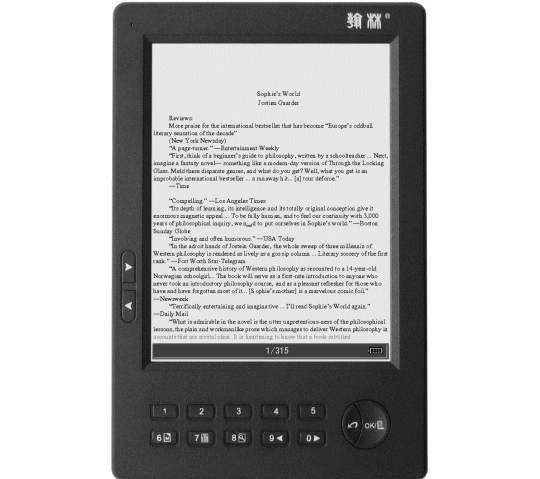Internet is quite full of posts, reviews and simply opinions floating around about how you could purchase iPhone instead of that expensive ebook reader (and be much cooler). Problem is – closest most authors of those seen electronic book reader is screenshot on gadget blog.
So here is review of my book reader. The one I see daily, own for almost a year and used to read dozens of books.
What it is
Book reader is innovative and emerging class of portable electronic devices that is focused to provide reading experience completely equal to reading from paper.
Core feature is electronic paper display (also known as e-ink after E Ink company that pioneered the technology).
It throws out of the window some display features we are used to:
- color;
- fast refresh time.
And instead provides:
- display by reflecting light, physically identical to paper;
- zero power to display image, battery is only spent on changing it.
Hanlin V3
My book reader is one of localized versions of Hanlin eReader V3.

hanlin_book_reader
Chinese gadget may not sound impressive but choice of book readers is still slim and their displays come from same manufacturers despite the brand stated on casing.
Hardware
- display 6” 600x800;
- CPU Arm 200Mhz;
- battery Nokia BL-5;
- SD-card slot;
- weight 240g (450g in bundled leather cover);
- dimensions 184х120х10mm.
Hardware set is suspiciously close to mobile phone (as are 0-9 button controls) so this may very well be one – repurposed for reading and e-ink screen.
6” screen is too big to fit in pocket (I think that 4” devices like Nokia N810 are limit for that) but is still easy to handle.
It connects to PC and charges via USB but with 1.1 standard it is easier to take SD card out (my model had it bundled) and use card-reader to drop books on it.
Battery life is roughly enough for reading 6-8 books with large font (larger font equals more page turns and so more battery spent).
Software
Device runs under Linux with custom interface. Firmware is easy to update and actively developed with new versions around every other month. Which is good because early version sucked and crashed repeatedly.
Numerous text formats are supported. Best performing are TXT, RTF and FB2, worst performing are PDF and HTML. Basically device is fine with pure text but has trouble interpreting and scaling complex markup.
Text size and even font can be customized. Aside from internal choice of fonts you can also copy to reader and use any TTF font you want (just grab NexusFont and look through fonts Windows has, I use Verdana).
Reading experience
Equal to reading mid-level (with slightly gray paper) book. Meaning it’s times better than anything devices with LCD screens can offer.
Text looks like it was printed on plastic. There is no flickering or blinding under sun rays. It really is like paper that learned to change what’s on it.
Overall
People who bash book reader prices ($250 and up depending on region, brand and model) complain that mobile phones (or whatever) are cheaper and can also be used to read books.
Well, hands are free and can be used instead of hammer to hit nails.
Truth is you can’t make valid decision about ebook reader until you had read few pages of text from one. Personally I was early adopter and started quite an epidemic among my friends and colleagues. Giving such device to active reader for few minutes is usually enough to see him with his own book reader next week.
So are you ready for reading from plastic or think paper books will be eternal? :)
Seelenwahnsinn #
Rarst #
How much longer will we eat pocket computing bullshit? | Rarst.net #
hardwarewiz #
netbook question #